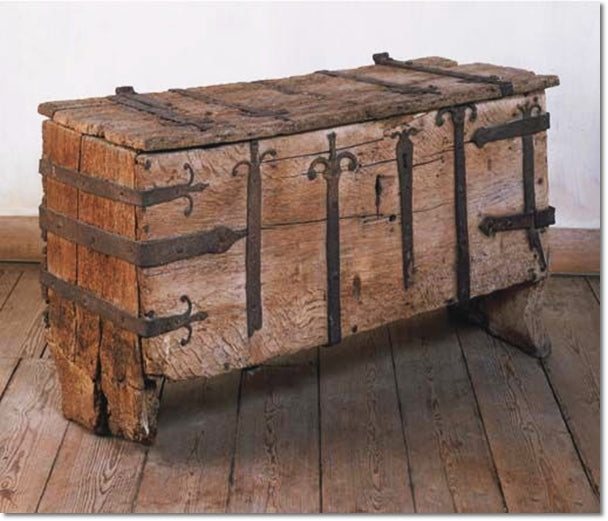Since the beginning of time, humans have always furnished their homes with the items they need to exist. Throughout the ages, the wooden crate box and chest have become the most common pieces of furniture found inside the home.
The simple storage chest has evolved into several forms and has been changed for various purposes. Wooden chests and trunks have evolved into the most practical and adaptable furniture in a home.
Wooden Create Box in History
Egyptians developed innovative ways to create boxes and wooden chests with dovetail joints as far back as 3,000 years ago. Their ceremonial and funeral sarcophagi feature amazing carving, metalwork, inlaid gems, and gilding. Even the poorest Egyptians kept their belongings in thin wooden chests.

People kept their things in wooden chests and coffers in ancient Greece and Rome, while the affluent had more elaborate, finely crafted trunks and treasure chests.
In comparison, life in life in Britain was difficult even for wealthy Saxons, so trunks were quite basic. We don't know much about Saxon trunks and chests, but they had to be simple and heavy.
The storage chest truly came into its own during the Medieval and Middle Ages, when the wills of affluent nobles revealed that they had hundreds of wooden treasure chests and trunks.
They were used as furniture, luggage, and storage chests, as well as treasure, tool, and weapon chests. They even served as food storage facilities.
The intended usage of wooden chests and trunks had a big impact on their design. Traveling by cart or wagon was simpler with designs that did not have feet or legs. Trunks and chests with legs were far preferable for use as storage chests since they kept their contents cleaner.
It was perfect for storing herbs and linens. The storage can keep clothing free of lice and moths.
Traveling wooden chests were typically coated in waxed leather to increase their weather durability, and they had flat lids to make them more usable as furniture for seating or other reasons.
Oak was the most popular wood for medieval wooden chests. Walnut was another popular choice in France but not in England. Poplar or pine was used to make wooden chests, and many softwood wooden chests from what is now Germany still exist.

These early wooden chests came to symbolize the owner's life and status, in addition to being the most essential utilitarian property in a home. The nobility would have chests that featured intricate embellishments and carvings.
Wooden chests began to have panels and friezes added to them. Arches and rosettes were common in the Tudor era, and patterns of flowers and scrolls were popular in the Renaissance period.
Wooden chests were also known as coffers, and they frequently featured huge hand-forged iron handles for convenience. Leather-covered coffers with a nailhead trim were common.
Different Types of Early Wooden Crate Boxes or Storage Chests
The first form of the wooden chest in medieval Europe was the hollowed-out, dome-top chest, which was built from one solid piece of wood scooped out from the inside and given a rounded top to match the shape of the log.
Eventually, two types of connected wooden chests emerged in the 1500s: the first, a basic planked box chest held together with nails, and the second, which now incorporated framed-up panels worked with the grain of the wood.
Wooden Chests Have Changed Over Time
The Wooden Box
A wooden chest is a variant of a wooden box, which features a basic flat lid. The design is straightforward, with a single board for each side, bottom, and lid. There are a total of six boards. The planks are simply fastened together and butting against each other.
The Standard Chest
The standard wooden chest is the most common basic design, and it's frequently used as a travel chest. It has a simple wooden box shape with no legs, butted joints, and it is often undecorated. It is reinforced by banding and strapping when used for travel. The top is frequently bent to allow water to fun off the top. To protect the wood, it is also covered with leather, wax, or oil finish.
The Six Board Chest
Despite the presence of more complex forms, the six-board chest takes the basic storage chest design a step further by extending the end panels to elevate the chest off the ground. This was popular between the 9th and 16th centuries. This was perhaps the most common wooden crate box in the home during this period.
Viking Chest
The chest is lifted off the ground by the expanded sideboards. Overall, Viking chests were strengthened with wider straps for reinforcement and protection, as well as stronger overlapping joints. The bands were often embellished.
The Viking wooden chest resembles the six-board chest in appearance. The two end pieces are extended down to form slab legs, which elevate the wooden chest off the ground (or ship deck). This wooden crate box with lid features both the front and end-piece overlapping one other, thus nails strengthened the connection in both directions, rather than the simple overlap design employed in the six-board chest, where the front is nailed to the end-piece.

Hutch Chest
The basic six-board chest was invented in the 13th century to elevate the chest off the ground by extending the front and back panels to the floor. On the lengthier panels, more robust tongue and groove joints were utilized, and the tops were flat. They were still popular in the 15th century. Large front panels provided more carving and decoration opportunities.
The Panel Chest
This wooden crate box used thinner, lighter wood panels, which were placed into stiles that were then bonded together. The panels were frequently decorated, carved, or painted.
The Dovetail Chest
Although dovetail joinery was not new in the 15th century, it was not a popular chest due to the difficulty in constructing it. However, these were the greatest chests of the time. Of course, it was a style that would come to dominate the nineteenth and twentieth centuries.
The 16th Century Wooden Crate Boxes
The storage box underwent the biggest changes throughout the sixteenth century. The modest chest or trunk began to emerge during the Elizabethan period. Boarded seats, stools, court cupboards, tool chests, and drawing tables were all made with the addition of legs and extensions.
The introduction of drawers in the mid-1600s was the most significant modification. Two drawers were added to the bottom of the chest for storing smaller objects. These were referred to as mule chests.
The modest modification quickly resulted in the entire frame being filled with drawers and the top being permanently attached to the frame. The chest was quickly transformed into a ‘chest of drawers.'
The simple chest had been converted into a functional piece of furniture that allowed for the organization and accessibility to stored items. Similar to the evolution of the chest, the construction of chests of drawers developed to provide better joints and styles.

The 17th Century Wooden Crate Boxes
In the early 17th century, wooden chests were plainer, heavier, and often always constructed of oak. But towards the end of the century, this wooden create box was becoming increasingly ornately adorned and was frequently made of walnut or mahogany. It began to be lacquered in vivid colors and was now embellished and inlaid with different materials such as pearls or bones.
The 18th to 20th Century Wooden Crate Boxes
With the expansion of the British Empire into new continents and territories and widespread emigration in the nineteenth and twentieth centuries, individuals needed storage chests to store and move their things, and simple pine chests were commonly utilized.
Transatlantic ship travel necessitated the creation of travel trunks. Steamer trunks were designed to appear like miniature portable wardrobes and were constructed of metal and wood. These travel wardrobes included many drawers and compartments, and they were fitted to hang clothes.
Art Deco as well Arts and Crafts largely influenced the styles of the wooden crate box throughout the 20th century. Because resources were few during WWII, modest chests and boxes were constructed out of readily available timbers like pine to store and carry military supplies.
The Modern Wooden Boxes
Nowadays, chests continue to be a common piece of furniture in many houses. The construction of modern chests has remained unchanged in the last 300 years.
Dovetail joints are still being utilized for higher-quality chests, and simple butted or mitered joints are used for lower-quality chests.
The current vogue for antique and vintage furniture, such as wooden chests and basic storage boxes from bygone centuries, has seen a rebirth of ancient chests from various times and styles, with their attractive patina and interesting history and stories.


